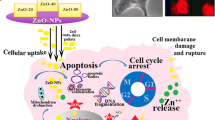Summary
The effects of nanometer realgar suspension on proliferation and apoptosis of human uterine cervix cancer cell line SiHa cells and oncogenic genes HPV16E6/E7 were investigated. A “micro-jet efflux” strategy was used for the preparation of nanometer realgar suspension. SiHa cells were treated with nanometer Realgar suspension in various concentrations (6.25, 12.5, 25 and 50 mg/L) for different durations (12, 24, 48 and 72 h). The inhibitive effect of nanometer realgar suspension on growth of SiHa cells was detected by MTT method. Special morphological changes of apoptosis were observed by transmission electron microscopy (TEM) and DNA fragments electrophoresis. The apoptotic rate was quantified by flow cytometry (FCM). The expression of HPV16E6/E7 mRNA and protein was assayed by RT-PCR and Western blot respectively. The results showed after being treated with 25 50 mg/L nanometer realgar suspension for 48 h, the survival rate of SiHa cells was decreased, and apoptotic rate markedly increased in a time-and concentration-dependent manner. TEM and DNA electrophoresis revealed the special morphological changes of apoptosis. The apoptotic rate of SiHa cells treated with nanometer realgar suspension was significantly higher than in the control group (P<0.01), and G0/G1 phase arrest appeared following treatment with nanometer realgar suspension in 25 and 50 mg/L for 48 h. RT-PCR and Western blot assay indicated that nanometer realgar suspension reduced the HPV16E6/E7 gene expression. Nanometer realgar suspension could inhibit the proliferation and induce apoptosis of SiHa cells. The mechanism may be related to the down-regulation of the HPV16E6/E7 gene expression.
Similar content being viewed by others
References
Huang N J, Xie Q Y, Luo L J. Determination of trace arsenic content in Jiu Ji Xing Jun capsules by UV spectrophotometry. Chin Tradi Potent Med (Chinese), 2005,27(7):772–774
Xu H, Chen Y H, Chen A X et al. Preparation of complex realgar creamor and clinical potency observation. Chin Hosp Pharm J (Chinese), 2002,22(3):183–184
Wang X B, Xi R G, Zhang Z R et al. Study on pharmacokinetics of nanoparticle realgar powders in rabbit. Pharm J Chin PL, 2002,18(6):324–326
Ning N, Peng Z F, Yuan L et al. Realgar nano-particles induce apoptosis and necrosis in leukemia cell lines K562 and HL-60. Chin J Chin Materia Medica (Chinese), 2005,30(2):136–140
Zhan X Q, Zhao F M, Guo L W. A pharmacokinetics study of super micronized realgar particles and the comparison of neoplasma-suppressive effects. J Prac Tradi Chin Med (Chinese), 2006,22(7):397–399
Zur Hausen H. Papillomaviruses and cancer: from basic studies to clinical application. Nat Rev Cancer, 2002,2(5):342–350
Nomine Y, Masson M, Charbonnier S et al. Structural and functional analysis of E6 oncoprotein: insights in the molecular pathways of human papillomavirus-mediated pathogenesis. Mol Cell, 2006,21(5):665–678
Ledwada T, Dlamini Z, Naicker S et al. Molecular genetics of human cervical cancer: role of papillomavirus and the apoptotic cascade. Biol Chem, 2004,385(8):671–682
Lu X N, Zheng J. The association of HeLa cell apoptosis induced by arsenic trioxide with the down-regulation of HPV18E6 oncogene and inhibition of telomerase activity. Chin J Oncol, 2005,27(5):265–268
Zheng J, Deng Y P, Lin C et al. Arsenic trioxide induces apoptosis of HPV-16DNA-immortalized human cervical epithelial cells and selectively inhibit viral gene expression. Int J Cancer, 1999,82(3):286–292
Um S J, Lee S Y, Kim E J et al. Down-regulation of human papillomavirus E6/E7 oncogene by arsenic trioxide in cervical carcinoma cells. Cancer Lett, 2002,181(1):11–22
Author information
Authors and Affiliations
Additional information
This project was supported by a grant from Hubei Challenging Program of Science and Technology, China (No. 2007AA301B38-3).
Rights and permissions
About this article
Cite this article
Liu, R., Pu, D., Liu, Y. et al. Induction of SiHa cells apoptosis by nanometer Realgar suspension and its mechanism. J. Huazhong Univ. Sci. Technol. [Med. Sci.] 28, 317–321 (2008). https://doi.org/10.1007/s11596-008-0320-5
Received:
Published:
Issue Date:
DOI: https://doi.org/10.1007/s11596-008-0320-5




